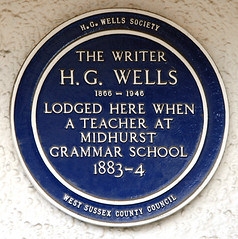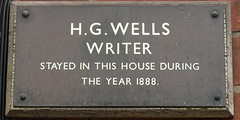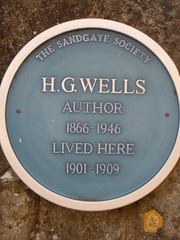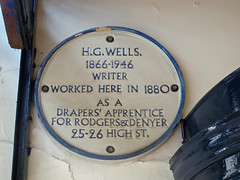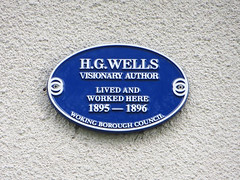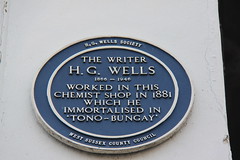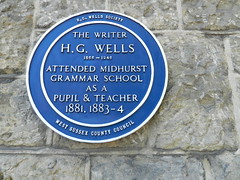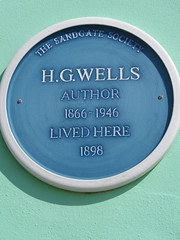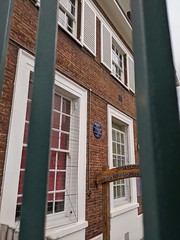H. G. Wells
Commemorated on 19 plaques
H. G. Wells 1866-1946 writer lived and died here
13 Hanover Terrace, London, United Kingdom where they lived and died (1946)
The writer H. G. Wells 1866-1946 lodged here when a teacher at Midhurst Grammar School 1883-4
North Street, Midhurst, United Kingdom where they lodged
H. G. Wells author 1866-1946 lived and worked here 1930-1936
Chiltern Court, Baker Street, London, United Kingdom where they lived and worked
H. G. Wells writer stayed in this house during the year 1888.
18 Victoria Street, Basford, Stoke-on-Trent, United Kingdom where they stayed
The site of the birthplace of H. G. Wells, born 21 September 1866
Alders (now Primark), 162 Bromley High Street, BR1 1HE, Bromley, United Kingdom where they was born (1866)
H. G. Wells Author 1866-1946 Lived here 1901-1909
Wells House (was Spade House), Radnor Cliff Crescent, Sandgate, United Kingdom where they lived
H. G. Wells 1866-1946 writer worked here in 1880 as a drapers' apprentice for Rodgers & Denyer 25-26 High St.
25-26 High Street, Windsor, United Kingdom where they worked
H. G. Wells visionary author Lived and worked here 1895 - 1896
143 Maybury Road, Woking, United Kingdom where they was
Herbert George Wells (1866-1946) H. G. Wells, the writer, lived in this district for several years. Between 1893 and 1894 he lived here and later, on his return from London, moved to 'The Avenue' in Worcester Park. In his novel 'Ann Veronica' (1909), Worcester Park appears as 'Morningside Park'.
25 Langley Park Road, Sutton, London, United Kingdom where they was
The writer H. G. Wells 1866 – 1946 worked in this chemist shop in 1881 which he immortalised in 'Tono-Bungay'
Church Hill Dental Surgery, Church Hill, Midhurst, United Kingdom where they worked (1881)
The writer H. G. Wells 1866 – 1946 attended Midhurst Grammar School as a pupil & teacher 1881, 1883-4
Capron House, Midhurst Grammar School, North Street, Midhurst, United Kingdom where they taught (1883-1884) and attended school (1881)
This 17th century building was first identified as an inn in 1714, when Chapel Street was an important highway. In the early 20th century it was popular with cyclists. H. G. Wells regularly dined and wrote here.
The Drum Public House, 16 Chapel Street, Petersfield, United Kingdom where they dined and wrote
H. G. Wells lived in this house in 1894 whilst writing The Time Machine
23 Eardley Road, Sevenoaks, United Kingdom where they lived (1894)
H. G. Wells author 1866-1946 lived here 1898
Granville Cottage, Granville Road East, Sandgate, United Kingdom where they lived (1898)
H. G. Wells author 1866-1946 lived here 1898-1901
20 Castle Road, Sandgate, United Kingdom where they lived (1898-1901)
Centenary Of Cinema 1996 #106
H. G. Wells author 1866-1946 lived here 1899-1909
Spade House, Radnor Cliff Crescest, Folkestone, United Kingdom where they lived (1899-1909)
H. G. Wells & Rebecca West's son born here 1913
Brig-y-don, Victoria Avenue, Hunstanton, United Kingdom where they lived
Mrs Knott's Dame School. H. G. Wells was a pupil here 1871-1874
7 South Street, Bromley, United Kingdom where they attended school (1871-1874)
H. G. Wells 1866-1946 The well known writer and benefactor officially opened the children's house on 24th October 1923
92 Bruce Road, London, United Kingdom where they was (1923)



